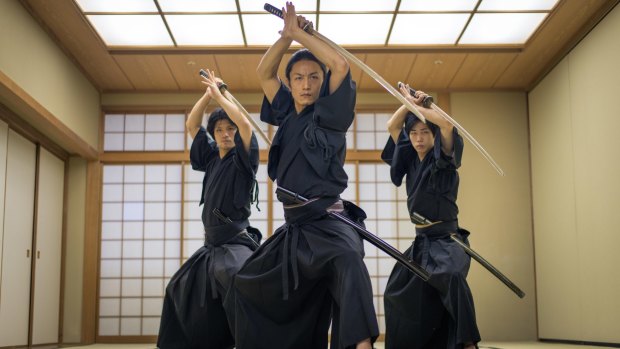This was published 5 years ago
Tokyo, Japan: A batto class is an opportunity try the Japanese art of swordsmanship

Japanese martial arts athlete training kendo in a dojo.Credit: Shutterstock
Every movement has a purpose. Nothing is careless. Nothing is wasted. As you sit in a corner of the dojo and watch the masters at work, you quickly learn that every step of their feet has been planned. Every sway of their hands, every scrape of their swords – it's all choreographed. It's all done for a reason.
The three masters are older than I'd expected, wizened men, the same types who walk the busy streets of downtown Tokyo just outside wearing suits and ties, clutching briefcases, making calls. Here though they're dressed in traditional hakamas, the flowing trousers that fit over a kimono-like gown. On their hips hang katanas, the cold steel of the samurai sword. On their faces are etched looks of concentration.
On command, the three men take a step forward and draw their swords. They slash the air with an overhead cut. They rake the sword back in an underhand slice. They pause, just for a second, their eyes pinned dead ahead, before they ease the swords back into the scabbards, brush their hands lightly over the hilts, and stand perfectly still once again.
This is what we're here to learn today: batto, the Japanese art of swordsmanship. To call sword-fighting an art may sound strange, until you see it practised before you. This is virtuosity. It's beauty. And it's serious.
Batto descended from samurai culture, though it's a practice all of its own, a style of drawing and slicing with a long blade that was first taught to the Japanese army in the 1920s. Every movement is designed to be repeated and perfected. It's almost trance-like, the way the masters draw and swing and sheath; draw and swing and sheath.
These batto experts have spent their entire lives training to achieve a blend of physical prowess and spiritual harmony. Today, we beginners are going to train for 45 minutes, and learn to chop a rolled-up tatami mat in half. It's almost the same.
At least the outfits are right. I've been kitted out in a hakama, the baggy trousers allowing my legs room to move, the gown, or hakamashita, freeing my arms to swing. To begin with I'm handed an old, blunt katana, the type that will do little damage to me or anyone in my sword-length radius.
First we learn to stand, one foot forward, the knee bent. We learn to grip the sword in its scabbard. We learn to draw it, to hold it in front of us and envision wreaking almighty hell on a roll of tatami ... and then we learn to sheath it. Repeat. Get comfortable with the sword. Learn the movements. The rolled tatami mats remain untouchable.
In that sense, those mats are the perfect metaphor for Japanese culture itself: so much of what makes this country fascinating is visible to the casual visitor, and yet it's also untouchable, impossible to participate in and to feel as if you understand.
That's why I'm taking this class. It's a way of not just looking at Japanese culture and history, but of feeling it, of being part of it. To hold a katana is to tap into the spirit of the samurai, to understand just for a moment, the passion and the dedication of those who keep their traditions alive.
And now it's time to slice. Having displayed my aptitude with drawing and sheathing, I'm finally handed a real katana, razor sharp, beautifully made, and placed in front of the tameshigiri, the rolled tatami. I'm told to draw my sword, to hold it in front of me, to raise it above my head and make an angled slash.
I fix my eyes on the mat. I go through the choreographed moves. I raise the sword, pause, and then bring it down, flashing before me, and just for that split second, for that moment as the steel slips through the tameshigiri like butter, as a hunk of mat flies away and I end my cut in the perfect position, I understand.
TRIP NOTES
Ben Groundwater was a guest of the Tokyo Convention and Visitors Bureau, and Inside Japan.
STAY
The Keio Plaza Shinjuku has beautiful rooms in the perfect location, walking distance to Shinjuku train station and other attractions. See keioplaza.com
DO
One-hour batto classes are offered through Inside Japan tours. See Insidejapantours.com
Sign up for the Traveller Deals newsletter
Get exclusive travel deals delivered straight to your inbox. Sign up now.